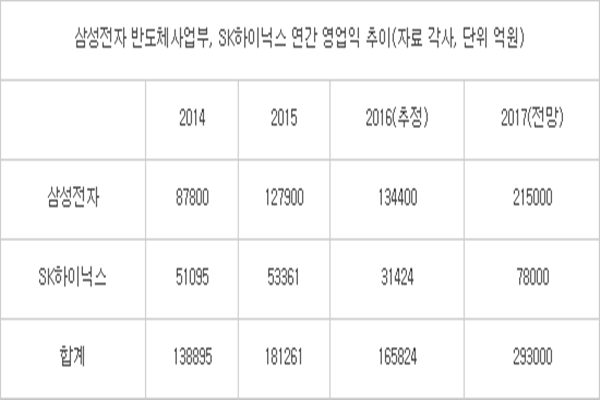South Korea’s semiconductor industries that are led by Samsung Electronics and SK Hynix are going to challenge themselves to make $25.6 billion (30.0 trillion KRW) in operating profits for the first time. There is a possibility of them making such operating profit as prices of memories are rising rapidly and as there is a possibility of eye-opening growth in consignment production (foundry) areas as well. This value is a value that will easily surpass operating profit of $15.3 billion (18.0 trillion KRW) in 2015 when it was a booming period for semiconductor industries. Their goals forecast unparalleled booming period in semiconductor industries.
Stock industries and semiconductor industries estimate that Samsung Electronics will make between $17.9 billion and $18.8 billion (21.0 trillion KRW and 22.0 trillion KRW) in operating profits from semiconductor business alone in 2017. They also estimate that yearly operating profit for SK Hynix will surpass $5.97 billion (7.00 trillion KRW) and approach $6.82 billion (8.00 trillion KRW). This indicates that their operating profits will increase by more than 60% and 100% respectively compared to last year and these values will be their highest values in their companies’ histories.
Experts in semiconductor industries estimate that South Korea’s semiconductor industries will make $25.6 billion (30.0 trillion KRW) in operating profits if operating profits from Dongbu Hitek and small and medium-sized fabless companies are added to operating profits of Samsung Electronics and SK Hynix.
Biggest reason why their operating profits are increasing is due to increase in prices of memories. Prices of memories have been rising since middle of last year. According to a market research company called DRAMeXchange, price of 4Gb DDR3 was $1.94 at the end of last year and it increased 55.2% since June of last year ($1.25). Price of NAND-flash memory is in a similar situation. Price of 64Gb MLC (Multi-Level Cell) NAND-flash memory, which is a major product, was $2.72 and it increased 21.4% since June of last year ($2.24).
“Price of major DRAM product increased up to $3.94 in December of 2013.” said a representative of a semiconductor industry. “There is still a possibility that the prices will continue to rise by looking at a current trend.”
“Although there is a chance that price of DRAM for PCs might fall in second quarter, it will be stabilized upwardly since supplies are limited.” said Director No Geun-chang of HMC Investment Securities Co., Ltd. Research Center. “According to prediction of prices of memories, yearly sales and operating profits for SK Hynix will increase to $19.9 billion (23.3 trillion KRW) and $6.65 billion (7.80 trillion KRW) respectively.”
“For Samsung Electronics, its sales and operating profits will increase to $54.6 billion (64.0 trillion KRW) and $18.3 billion (21.5 trillion KRW) respectively due to increase in prices of memories.”
Reason why prices of memories are rising is due to limitation in increase in amount of supply rather than increase in number of demands. This kind of phenomena is clear from DRAM memories. Samsung Electronics is not taking a fast approach in new investments and changing their technologies. Industries believe that Samsung Electronics is making such approach to protect their profit ratio regarding discontinuation of Galaxy Note 7.
Fact that technologies that make DRAM memories smaller have reached its limitations is also seen as another reason. Due to this reason, amount of investments have also increased according to geometric progression. In the past, production lines that can make 150,000 300mm wafers could have been made with investments between $4.26 billion and $5.11 billion (5.00 trillion KRW and 6.00 trillion KRW). Recently this cost increased up to $8.52 billion (10.0 trillion KRW).
Recently amount of investments into NAND-flash memories is increasing as layer-built 3D technologies have been commercialized. However experts believe that there will not be sudden decrease in prices when new facilities are built since demands for SSD (Solid State Drive) for PCs and servers are steady.
Trend of growth of foundry fields is also steady. Samsung Electronics’ System LSI Business Department’s Foundry Business Team has secured many big customers such as Qualcomm. Dongbu Hitek’s performance is also making a positive trend as it rides IoT trend.
“Main reason why prices of DRAM memories are increasing is due to lack of supplies and there aren’t any signs of new investments.” said an expert in semiconductor industry. “Although there are new investments for 3D NAND-flash memories, there is a chance that even these might get delayed if recent investigations done by special prosecutor team on CEOs of major businesses are extended.”
Staff Reporter Han, Juyeop | powerusr@etnews.com
